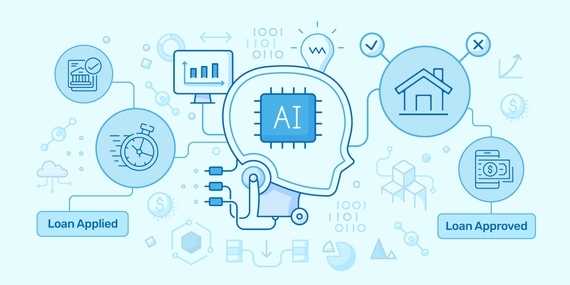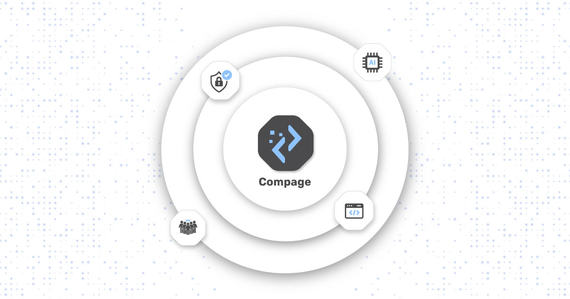
Smart Mortgages - Generative AI Reshaping Lending Dynamics
The mortgage industry has experienced significant shifts within various facets of lending process as a result …

Digital transformation has reshaped how businesses operate, keeping customers at the forefront. Its urgency is undeniable, with global spending in this area reaching a staggering $3.4 trillion by 2026.
One key strategy for achieving digital transformation is the cloud-native approach. Cloud-native technologies, inherently scalable and automated, combine with DevOps and agile methodologies to enable continuous innovation and delivery across diverse infrastructures, driving superior business results. Purpose-built for cloud environments, the cloud-native approach empowers development teams to build next-generation microservices-based applications containerized for efficient deployment.
Let’s explore what benefits cloud-native transformation brings to your business.
Continuous delivery: Continuous delivery streamlines software delivery, boosting efficiency and agility. Automated build, test, and deployment accelerate releases and feedback loops. Developers deploy with confidence, knowing updates are thoroughly tested.
DevOps: Integrating development and operations practices within a cloud-native framework fosters cloud adaptability, ensuring consistent delivery of high-quality software and maximizing return on investment (ROI). Continuously evolve DevOps strategies alongside business needs for optimal results.
Microservices: Microservices address the limitations of monolithic applications, enabling agile development. Breaking applications into small, independent services with diverse languages and platforms facilitates rapid feature deployment without impacting other services. Exposed APIs streamline communication and scaling for system demands.
Containers: Containers streamline software packaging and execution, providing predictability, repeatability, and immutability. Minimize deployment errors by packaging all components within a container - libraries, dependencies, and even the operating system. This leverages the benefits of virtual machines, offering efficiency in deployment workflows without the full OS overhead.
Cloud-native application development relies on containers, microservices, and DevOps for fast, flexible, and secure app building. It speeds up time-to-market, boosts efficiency, and cuts costs while keeping up with tech innovations, making software delivery modern and adaptable to business needs.
Real-time Analytics: Cloud-native applications excel in handling transient data influx by enabling real-time analytics. They allow businesses to quickly detect performance issues, troubleshoot problems, and analyze customer behavior. Additionally, reputable cloud-native infrastructure vendors ensure compliance with regulations like HIPAA, GDPR, and country-specific requirements.
Serverless Platforms and Code Reusability: Cloud-native applications leverage serverless platforms to deploy specific code segments that execute isolated functions. This approach facilitates code reuse across projects/code reusability, saving development time and effort. Each component of cloud-native services contains its logic, enhancing modularity and scalability.
Cost Efficiency: Operating on modern cloud infrastructure, cloud-native applications adopt a pay-as-you-go model, reducing costs compared to traditional on-premises hardware maintenance. The agility and modularity of cloud-native development lead to significant reductions in development time and resources, further driving down IT expenses.
Enhanced Customer Experience: Cloud-native applications minimize time-to-market, ensuring timely product delivery. Additionally, their ease of iteration allows businesses to swiftly incorporate new features to meet evolving customer needs, delivering a personalized buying experience.
Service Integration: Microservices offer flexibility and scalability, but integrating them within cloud-native environments can be challenging. The general complexity of integration, compounded by data integration backlogs, meticulous service integration is crucia for success in cloud-native development.
Visibility: Cloud-native apps produce tons of data from each service, making it hard to monitor what’s going on. It’s tough to pick out the most important data for analysis among all the metrics. Plus, traditional tools might not handle cloud monitoring well.
Persistent Data Storage: Many cloud-native technologies encounter a common hurdle: persistent data storage. Containers, serverless functions, and applications deployed using immutable infrastructure models typically lack mechanisms for storing data permanently within themselves, as internal data is wiped upon application shutdown.
Cultural Shift and Organizational Transformation: An often-underestimated challenge in cloud-native transformation is the cultural shift demanded within organizations. It requires adopting new DevOps methodologies, promoting cross-functional collaboration, and nurturing continuous improvement. The cultural shift is indispensable for fostering innovation, agility, and resilience amidst evolving technologies.
Nearly three out of every four non-cloud apps are expected to move to the coud over the next three years (IBM). Optimizing the application cycle is essential for today’s modern enterprises: it helps businesses meet customer expectations, stay adaptable in operations, and speed up innovation.
Effective cloud-native transformation involves four key stages: the technology disruptor phase, where organizations adopt new base technology; the cloud as a capability enabler stage, where they build new capabilities; the innovation facilitator phase; and the business disruptor phase, where the cloud becomes a driver for change. To adopt cloud technologies, organizations must ensure clarity on their goals, separate their vision from the plan, start small, and establish a feedback loop.
Plan: Before anything else, organizations need to make a plan. This involves figuring out what they want to achieve with cloud-native technology. They should set clear goals and understand how cloud-native can help them reach those goals. This step also involves assessing their current infrastructure and determining what needs to change to transition to the cloud.
Source: Once the plan is in place, it’s time to source the necessary resources. This includes choosing the right cloud service provider and tools for the job. Organizations need to research different options and select the ones that best fit their needs and budget. They also need to consider security, scalability, and compatibility with their existing systems.
Develop: With the tools and resources in hand, organizations can start developing their cloud-native applications. This involves building and testing software designed to run on cloud infrastructure. Development teams need to adopt agile practices and DevOps principles to ensure that their applications are flexible, scalable, and resilient.
Distribute: Once the applications are developed, it’s time to distribute them to users. This might involve deploying them on a public cloud, private cloud, or hybrid cloud environment. Organizations need to carefully manage the deployment process to ensure that their applications are available and performant. They must also monitor and optimize their cloud infrastructure to meet their needs.
Our, auto-code generator, Compage, significantly advances digital transformation by automating backend development tasks, expediting product delivery, and facilitating the adoption of cloud-native architectures. See how Compage can simplify modern application development:
Microservice development: With Compage, developers can easily create microservices by just giving the required input, and in turn helping businesses to cut microservice development costs by 90% (per microservice)
Portable Containers: Compage assists developers in optimizing the performance and portability of their containerized applications. It guarantees the portability of containers, meaning they can be deployed across different platforms and environments without modification
Shift-security left: Moreover, Compage enables organizations to enforce robust security policies, ensuring the integrity of their software supply chain. This not only meets stringent security standards but also supports secure digital transformation initiatives, essential for modernizing IT infrastructure.
Want to explore how Compage can elevate cloud-native adoption? Reach out to schedule a demo today. You can also visit our platform on GitHub and connect with us on LinkedIn for the newest updates and insights.

The mortgage industry has experienced significant shifts within various facets of lending process as a result …

Organizations today face a slew of challenges that significantly impact their growth. According to a survey …

Industry 4.0 has swept through the manufacturing industry, with manufacturing technology companies finding …
Finding the right talent is pain. More so, keeping up with concepts, culture, technology and tools. We all have been there. Our AI-based automated solutions helps eliminate these issues, making your teams lives easy.
Contact Us